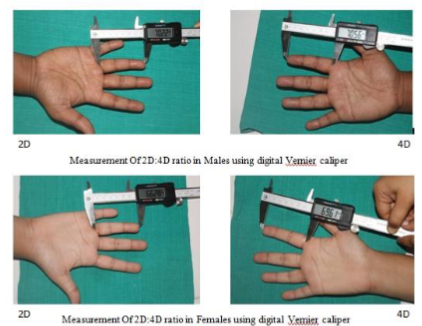Hormonal Fingerprints: A Potential Biomarker for Periodontal Disease
Main Article Content
Abstract
Background: Hormonal fingerprints/ 2D:4D ratio of an induvidual was offlate considered as a potential biomarker in many medical diseases and conditions. However in dentistry, this 2D:4D ratio has not been substantiated for its role of dental conditions yet. As the role of steroid hormones in periodontal health has well been documented in the literature and 2D:4D ratio is a result of prenatal androgen exposure. Our aim is to evaluate its role in the periodontal status of the individuals.
Materials and Methods: A study proves 150 were evaluated for periodontal status using Russell’s Periodontal index and 2D:4D ratio was measured using digital vernier callipers. ‘t’ test, chi square test and binary regression analysis were the statistical tests implied in the results.
Results: A higher prevalence of low 2D:4D ratio was evidenced in males compared to females. However females evidenced good periodontal health than males. This increased incidence of periodontitis in males can be attributed to the environmental and psychosocial factors.
Conclusion: The role of 2D:4D ration in periodontitis appears obscure as although the prenatal androgen exposure seems to be higher in males which in turn exhibits beneficial effect on periodontal tissues. Our study demonstrated poor periodontal health compared to females.
Article Details
References
Rajawat A, Majeti C, Podugu UK, Kaushik M, Nagamaheshwari X, Mehra N. Association of hormonal fingerprints and dental caries: A pilot study. J Conserv Dent 2020;23:337-40.
Biomarkers Definitions Working Group, Atkinson Jr AJ, Colburn WA, DeGruttola VG, DeMets DL, Downing GJ, Hoth DF, Oates JA, Peck CC, Schooley RT, Spilker BA. Biomarkers and surrogate endpoints: preferred definitions and conceptual framework. ClinPharmacolTher 2001;69:89-95.
Mayeux R. Biomarkers: Potential uses and limitations. NeuroRx 2004;1:182-8.
Manning JT, Scutt D, Wilson J, Lewis-Jones DI. The ratio of 2nd to 4th digit length: A predictor of sperm numbers and concentrations of testosterone, luteinizing hormone and oestrogen. Hum Reprod 1998;13:3000-4.
Putza DA, Gaulin SJ, Sporter RJ, McBurney DH. Sex hormones and finger length. What does 2D:4D indicate? Evol Hum Behav 2004;25:182-99.
Bhardwaj A, Bhardwaj SV. Effect of Androgens, Estrogens and Progesterone on Periodontal Tissues. J Orofac Res 2012;2:165-170.
KatzIA, EpsteinS. Bone mineral metabolism at the menopause: Determinants and markers. In: Piero P Foa, editor, Humoral factors in the regulation of tissue growth. 1st ed. New York: Springer-Verlag 1993:211-23.
Jeevanandam S, Muthu PK. 2D: 4D ratio and its implications in medicine. Journal of clinical and diagnostic research: J Clin Diagn Res. 2016;10:CM01–03.
Priyanka GN, Prasad MG, Radhakrishna AN, Ramakrishna J, Jyothi V. The hormonal fingerprints and BMI: Implications for risk factors in dental caries and malocclusion. J Clin Diagn Res 2016;10: ZC06-9.
Verma P, Hegde AM. Digit Ratio and Dental Caries: A Sexually Dimorphic Trait. Int J Clin Pediatr Dent 2018;11:1-6.
Issrani R, Aljohani F, Prabhu N, Alam MK. Assessment of 2D: 4D ratio for the early diagnosis of caries and malocclusion in 7-15-year-old children. Bang J Med Sci. 2021;20:154-8.
George R. Human finger types. Anat Rec 1930;46:199-204.
Brown W, Hines, M, Fane, B, Breedlove, S. Masculinized finger length patterns in human males and females with congenital adrenal hyperplasia. Horm Behav. 2002;42: 380-86.
Agnihotri AK, Purwar B, Jeebun N, Agnihotri S. Determination of sex by hand dimensions. Internet J Forensic Sci 2006;1:12–24.
Kanchan T, Rastogi P. Sex determination from hand dimension of North and South Indians. J Forensic Sci 2009;54:546–50.
Williams JHG, Greenhalgh KD, Manning JT. Second to fourth finger ratio and possible precursors of developmental psychopathy in preschool children. Early Hum Dev. 2003;72:57–65.
Lakshmi CR, Radhika D, Prabhat M, Bhavana S mulk, Sai Madhavi N. Association between genetic taste sensitivity, 2D:4D ratio, dental caries prevalence, and salivary flow rate in 6-14-year-old children: a cross- sectional study. J Dent Res, Dental Clinics, Dental Prospects. 2016;10:142-7.
Guncu GN, Tozum TF, Caglayan FE. Effects of endogenous sex hormones on the periodontium—Review of literature. Aus Dent J. 2005;50:138-45.
Wilson JD, Gloyna RE. The intranuclear metabolism of testosterone in the accessory organs of reproduction. Recent Prog Horm Res 1970;26:309-36.
Bhardwaj A, Bhardwaj SV. Effect of androgens, estrogens and progesterone on periodontal tissues. J Orofac Res. 2012:165-70.
Nirola A, Batra P, Kaur J. Ascendancy of sex hormones on periodontium during reproductive life cycle of women. J Int Clin Dent Res Organ 2018;10:3-11.
Nazir MA. Prevalence of periodontal disease, its association with systemic diseases and prevention. Int J Health Sci. 2017;11:72–80.
Ioannidou E. The sex and gender intersection in chronic periodontitis. Front Public Health. 2017;5:189.
Ahamed TS, Rajasekar A, Mathew M G Prevalence of Periodontal Disease among Individuals between 18-30 Years of Age: A Retrospective Study. Ann Med Health Sci Res.2021;11:198-204.
Schulze A, Busse M. Gender Differences in Periodontal Status and Oral Hygiene of Non-Diabetic and Type 2 Diabetic Patients. Open Dent J. 2016 9;10:287-97.
Lipsky MS, Su S, Crespo CJ, Hung M. Men and Oral Health: A Review of Sex and Gender Differences. Am J Mens Health. 2021;15:1-8.
Goel K, Sharma S, Baral DD, Agrawal SK. Current status of periodontitis and its association with tobacco use amongst adult population of Sunsari district, in Nepal. BMC oral health. 2021;21:1-9.
de AraujoNobre M, Malo P. Prevalence of periodontitis, dental caries, and peri-implant pathology and their relation with systemic status and smoking habits: Results of an open-cohort study with 22009 patients in a private rehabilitation center. J Dent. 2017;67:36-42.
Genco RJ, Ho AW, Grossi SG, Dunford RG, Tedesco LA. Relationship of stress, distress and inadequate coping behaviors to periodontal disease. J Periodontol. 1999;70:711-23.

